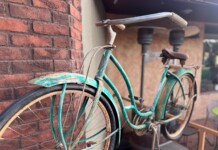The annual Medicine of Cycling Bike Fit Symposium took place at the USA Cycling headquarters in Colorado Springs in mid-August, bringing together a highly regarded group of bike fitters from around the USA, and further afield.
Presenters included sports medicine and bike fit advisor to Specialized Bicycles, Andy Pruitt; sports medicine and bike fit advisor to Trek Bicycles, Mark Timmerman; strength and conditioning coach, Greg Choat; Physical Therapists, fitters and educators Curtis Cramblett, Greg Robidoux and Brian Adams; Bike fitter since year 1, Happy Freedman; Californian fitter of note, Steve Carre; and the legendary John Cobb. Topics covered included overuse injuries of the lower limb; foot evaluation and intervention; pelvic, trunk and core assessment, influence of crank length on aerodynamic positioning; case studies and more.
Attendees encompassed bike shop owners, physical therapists, orthopaedic specialists, independent bike fitters, athletic trainers, and cycling coaches, making for a diverse gathering with a common interest. And that common interest is helping you – the cyclist – have a positive relationship with your bicycle. This relationship encompasses everything from injury prevention to aerodynamic advantage, including comfort, efficiency, power generation, and bike handling.
Here are a few notes of interest and relevance to share, to encourage you to think about your own bike-body relationship.
Saddle
You can’t fire a cannon from a canoe. Generating force and applying it to the pedals can only happen from a stable foundation, and that foundation is the bicycle saddle. If you are not stable and well supported by the saddle, you are not able to effectively generate power. Although force is applied at the pedals, it starts at the saddle (and with the core: muscles and fascia). A bike fit is saddle specific. If you change your saddle to a different one, you have just changed your fit position.
Shoes
The only place you are mechanically attached to the bike is at the pedals. Shoe selection, in-shoe support, and cleat position are all important for not just foot comfort, but also knee protection. The number one issue with cycling shoes is their width, or lack of. Cycling shoes need to be wide enough for your feet, and sized for your arch length. The correct in-shoe support (semi custom or custom cycling orthotics) can do wonders for both foot and knee comfort by securing, stabilizing and supporting your foot in the shoe, resulting in positive effects up the kinetic chain. Insoles for cycling are not the same as insoles for running or hiking. The biomechanics of what the feet are doing are very different, and the support requirements are different.
Hands
If you get numb hands riding, and the numbness goes away after the ride, it’s due to temporary nerve compression from too much weight on the hands. This can be from bars being either too far away and too low, the opposite! Aim for a light touch on the bars so that you are not being held up by the bars, nor pushing yourself back off them. Handlebar width is more critical for woman than men, and generally woman are riding on bars too wide. Shopping for gloves? Foam padding is better than gel padding for comfort, even though gel padding is marketed as being superior. Same for cycling chamois selection.
Fitness
Your overall strength and conditioning can be limiting you a lot more on the bike than you think. Improving core strength, range of motion, and stability (control through motion) off the bike all help when you are on the bike. Deadlifts are superior to squats for developing cycling power. You can’t stretch the IT band, but you can strengthen your glutes.
Aerodynamics
For time trial riders and triathletes, aerodynamics is very important, and a lower torso is generally more aerodynamic. However the ability to get lower AND maintain power generation is constrained by the hip angle (femur to torso). If you get low but lose the ability to generate power in doing so, you may in fact be going slower. The best way to get low and keep an open hip angle to generate power is to use short crank arms, e.g. 135mm – 155mm. When changing to significantly shorter cranks, increase the size of the chain-rings to maintain pedaling load feedback. There is no evidence to suggest a correlation between a cyclist’s height and their crank length, and there is no correlation between crank length and power output. A side benefit of shorter cranks is to reduce the development of external iliac arterial fibrosis – a condition causing pain and weakness in one or both legs that has ended the career of quite a few cyclists.
Please contact me if you have any questions about this annual conference, or want to know more about the topics presented here.
John Higgins operates BikeFitr – an independent bike fitting studio, and Fit Kit Systems – which provides bike sizing and fitting solutions to bicycle retailers and fitters. Contact: [email protected]












